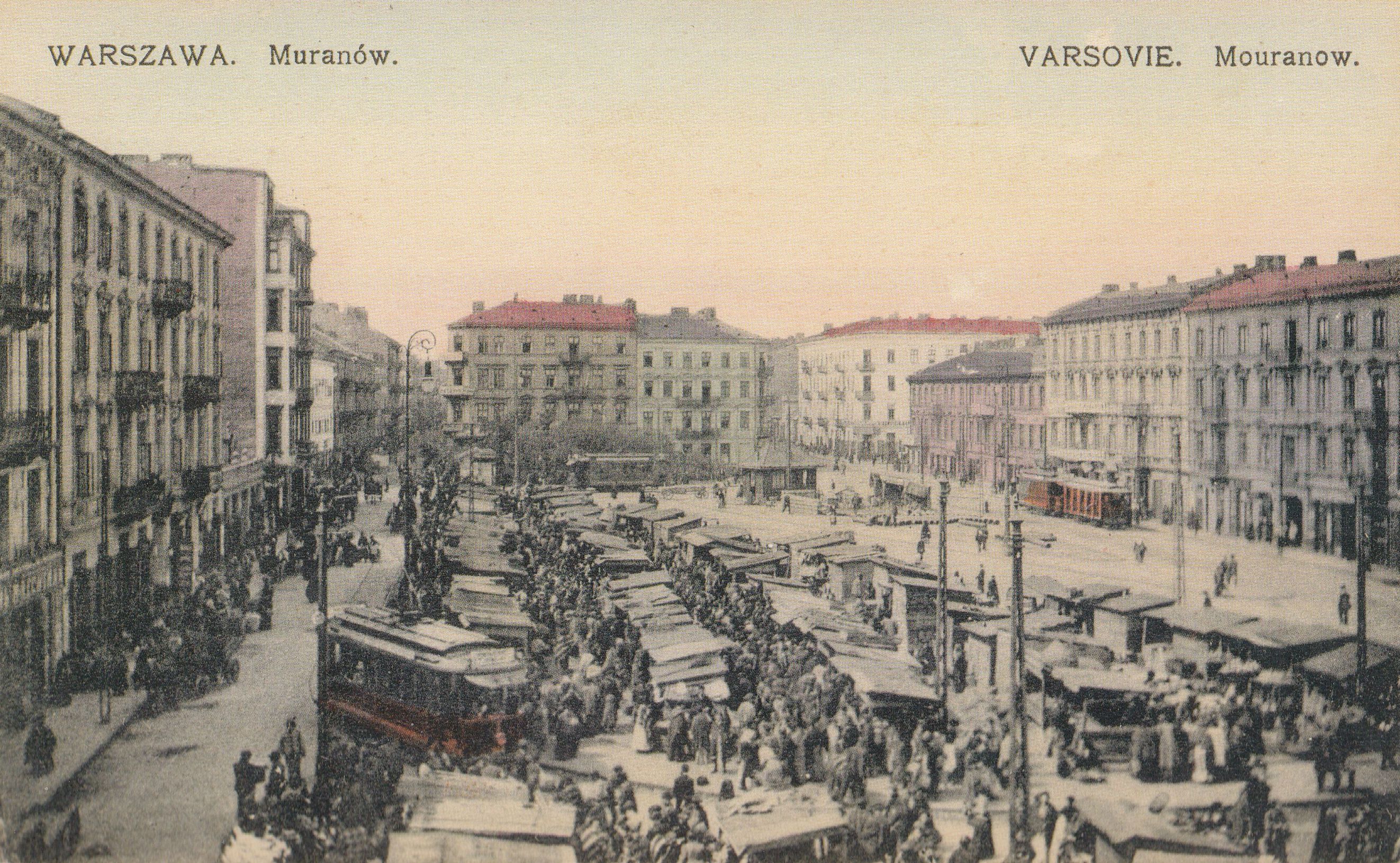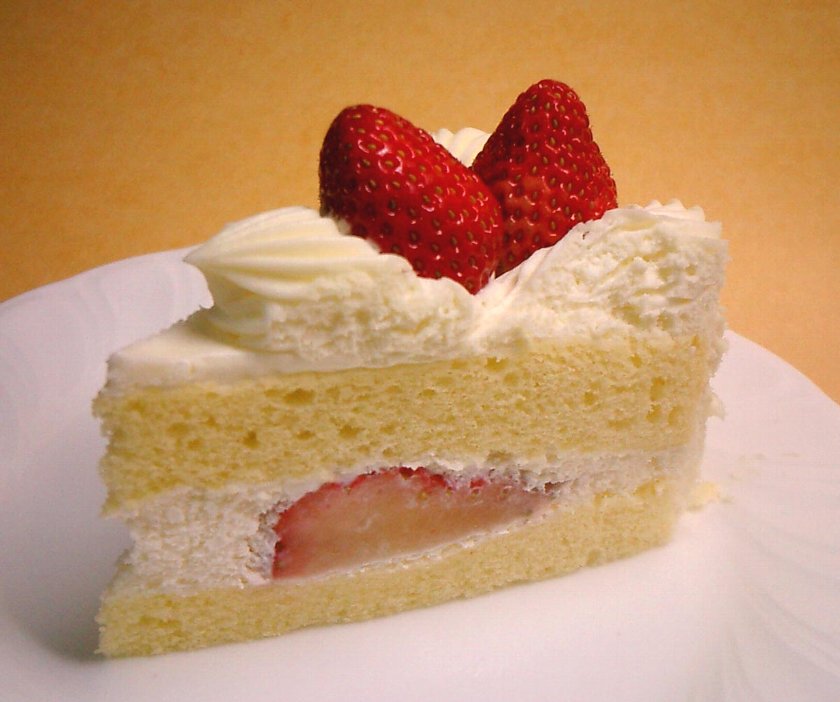|
Wuzetka
Wuzetka (pronounced ) is a chocolate sponge and cream pie which originated in Warsaw, Poland. Its name is probably derived from the Warsaw W-Z Route, on which the confectionery that first began to sell the dessert in the late 1940s was located. Traditional to Varsovian cuisine, the dessert was exclusively served by cafés and restaurants in Warsaw, but soon became a beloved home-made food in Poland. History The dessert most likely originated at the turn of the 1940s and 1950s in one of Warsaw's newly founded sweet shops. However, the precise origin of the name is debatable; historians and certain sources agree that the cake was probably named after the Warsaw W-Z Route (East-West Route), which ran next to the shop. Other sources state that the name comes from the acronym "WZC", which either stood for the Warsaw Confectionery Plants () or for the Polish term "pastry with chocolate" ('). The abbreviation "WZK" for "pastry with cream" (') is also a possibility. The confectioner ... [...More Info...] [...Related Items...] OR: [Wikipedia] [Google] [Baidu] [Amazon] |
Warsaw W-Z Route
Warsaw, officially the Capital City of Warsaw, is the capital and List of cities and towns in Poland, largest city of Poland. The metropolis stands on the Vistula, River Vistula in east-central Poland. Its population is officially estimated at 1.86 million residents within a Warsaw metropolitan area, greater metropolitan area of 3.27 million residents, which makes Warsaw the List of cities in the European Union by population within city limits, 6th most-populous city in the European Union. The city area measures and comprises List of districts and neighbourhoods of Warsaw, 18 districts, while the metropolitan area covers . Warsaw is classified as an Globalization and World Cities Research Network#Alpha 2, alpha global city, a major political, economic and cultural hub, and the country's seat of government. It is also the capital of the Masovian Voivodeship. Warsaw traces its origins to a small fishing town in Masovia. The city rose to prominence in the late 16th cent ... [...More Info...] [...Related Items...] OR: [Wikipedia] [Google] [Baidu] [Amazon] |
Polish Cuisine
Polish cuisine ( ) is a style of food preparation originating in and widely popular in Poland. Due to History of Poland, Poland's history, Polish cuisine has evolved over the centuries to be very eclectic, and shares many similarities with other national cuisines. Polish cooking in other cultures is often referred to as ''à la polonaise''. Polish cuisine is rich in meat, especially pork, chicken and game, in addition to a wide range of vegetables, spices, fungi and mushrooms, and herbs. Polish Meals – Polish Food – Polish Cuisine . Retrieved 6 June 2011. It is also characterised by its use of various kinds of kluski, pasta, cereals, kasza, kasha and pulses. [...More Info...] [...Related Items...] OR: [Wikipedia] [Google] [Baidu] [Amazon] |
Poland
Poland, officially the Republic of Poland, is a country in Central Europe. It extends from the Baltic Sea in the north to the Sudetes and Carpathian Mountains in the south, bordered by Lithuania and Russia to the northeast, Belarus and Ukraine to the east, Slovakia and the Czech Republic to the south, and Germany to the west. The territory has a varied landscape, diverse ecosystems, and a temperate climate. Poland is composed of Voivodeships of Poland, sixteen voivodeships and is the fifth most populous member state of the European Union (EU), with over 38 million people, and the List of European countries by area, fifth largest EU country by area, covering . The capital and List of cities and towns in Poland, largest city is Warsaw; other major cities include Kraków, Wrocław, Łódź, Poznań, and Gdańsk. Prehistory and protohistory of Poland, Prehistoric human activity on Polish soil dates to the Lower Paleolithic, with continuous settlement since the end of the Last Gla ... [...More Info...] [...Related Items...] OR: [Wikipedia] [Google] [Baidu] [Amazon] |
Muranów
Muranów () is a neighbourhood in the districts of Śródmieście (Downtown) and Wola in central Warsaw, the capital of Poland. It was founded in the 17th century. The name is derived from the palace belonging to Simone Giuseppe Belotti, a Venetian architect, who originally came to Warsaw from the island of Murano. It is the northernmost neighbourhood of the downtown area. Muranów was once Warsaw's most multicultural, densely-populated and diverse precinct with historical architecture, bazaars, churches and synagogues. In the interwar period (1918–1939), the district was primarily inhabited by Jews. As a result, the Warsaw Ghetto was set up in Muranów in 1940 by the occupying Germans. After the ghetto uprising in 1943 commanded by Mordechaj Anielewicz, the district was completely destroyed. Only the sparse few buildings survived the war. Muranów was entirely redeveloped after the war into a socreal-modernist district with 1950s-1960s housing estates, tower blocks and, mor ... [...More Info...] [...Related Items...] OR: [Wikipedia] [Google] [Baidu] [Amazon] |
Polish Desserts
Polish may refer to: * Anything from or related to Poland, a country in Europe * Polish language * Polish people, people from Poland or of Polish descent * Polish chicken * Polish brothers (Mark Polish and Michael Polish, born 1970), American twin screenwriters * Kevin Polish, an American Paralympian archer Polish may refer to: * Polishing, the process of creating a smooth and shiny surface by rubbing or chemical action ** French polishing, polishing wood to a high gloss finish * Nail polish * Shoe polish * Polish (screenwriting), improving a script in smaller ways than in a rewrite See also * * * Polishchuk (surname) * Polonaise (other) A polonaise ()) is a stately dance of Polish origin or a piece of music for this dance. Polonaise may also refer to: * Polonaises (Chopin), compositions by Frédéric Chopin ** Polonaise in A-flat major, Op. 53 (, ''Heroic Polonaise''; ) * Polon ... {{Disambiguation, surname Language and nationality disambiguation pages ... [...More Info...] [...Related Items...] OR: [Wikipedia] [Google] [Baidu] [Amazon] |
Sweet Pies
Sweetness is a basic taste most commonly perceived when eating foods rich in sugars. Sweet tastes are generally regarded as pleasurable. In addition to sugars like sucrose, many other chemical compounds are sweet, including aldehydes, ketones, and sugar alcohols. Some are sweet at very low concentrations, allowing their use as non-caloric sugar substitutes. Such non-sugar sweeteners include saccharin, aspartame, sucralose and stevia. Other compounds, such as miraculin, may alter perception of sweetness itself. The perceived intensity of sugars and high-potency sweeteners, such as aspartame and neohesperidin dihydrochalcone, are heritable, with gene effect accounting for approximately 30% of the variation. The chemosensory basis for detecting sweetness, which varies between both individuals and species, has only begun to be understood since the late 20th century. One theoretical model of sweetness is the multipoint attachment theory, which involves multiple binding sites be ... [...More Info...] [...Related Items...] OR: [Wikipedia] [Google] [Baidu] [Amazon] |
Cakes
Cake is a flour confection usually made from flour, sugar, and other ingredients and is usually baked. In their oldest forms, cakes were modifications of bread, but cakes now cover a wide range of preparations that can be simple or elaborate and which share features with desserts such as pastries, meringues, custards, and pies. The most common ingredients include flour, sugar, eggs, fat (such as butter, oil, or margarine), a liquid, and a leavening agent, such as baking soda or baking powder. Common additional ingredients include dried, candied, or fresh fruit, nuts, cocoa, and extracts such as vanilla, with numerous substitutions for the primary ingredients. Cakes can also be filled with fruit preserves, nuts, or dessert sauces (like custard, jelly, cooked fruit, whipped cream, or syrups), iced with buttercream or other icings, and decorated with marzipan, piped borders, or candied fruit. Cake is often served as a celebratory dish on ceremonial occasions, such as ... [...More Info...] [...Related Items...] OR: [Wikipedia] [Google] [Baidu] [Amazon] |
Karpatka
Karpatka is a traditional Polish cream pie with some sort of vanilla buttercream filling – aerated butter mixed with eggs beaten and steamed with sugar (''krem russel''), aerated butter mixed with ''crème pâtissière'' (according to Polish gastronomy textbooks made from whole eggs) or just thick milk kissel enriched with melted butter.For the purposes of this article, it is assumed that any boiled cream made of milk kissel enriched with egg yolks (or whole eggs) qualifies as ''crème pâtissière'' Professionally it is made of one sheet of short pastry covered with a layer of choux pastry with a thin layer of marmalade and a thick layer of cream in between. Nevertheless, the version with two layers of choux pastry is popular. The cake is cut into squares or rectangles and dusted with icing sugar. The dessert takes its name from the mountain-like pleated shape of the powdered choux pastry, which resembles the snowy peaks of the Carpathian Mountains – ''Karpaty'' in Polish. ... [...More Info...] [...Related Items...] OR: [Wikipedia] [Google] [Baidu] [Amazon] |
Napoleonka
Napoleonka (; colloquially ''kremówka'' (), is a Polish type of cream pie. It is made of two layers of puff pastry, filled with whipped cream, ''crème pâtissière'' (according to Polish gastronomy textbooks made from whole eggs; some versions consist of melted butter) or just thick milk kissel enriched with melted butter,For the purposes of this article, it is assumed that any boiled cream made of milk kissel enriched with egg yolks (or whole eggs) qualifies as ''crème pâtissière''. or sometimes filled with egg white cream. It is usually sprinkled with powdered sugar but it also can be decorated with cream or covered with a layer of icing. In some places in Poland the cake is known as (roughly translated as "cream cake"), in others, it is called . This Polish "war" between names and has been subject to a satirical drawing by the Polish illustrator Andrzej Mleczko. The cake itself is a variation of ''mille-feuille'' – a French dessert made of three layers of puff pa ... [...More Info...] [...Related Items...] OR: [Wikipedia] [Google] [Baidu] [Amazon] |
List Of Polish Desserts
This is a list of Polish desserts. Polish cuisine has evolved over the centuries to become very eclectic due to Poland's history. Polish cuisine shares many similarities with other Central Europe, Central European cuisines, especially German cuisine, German, Austrian cuisine, Austrian, and Hungarian cuisine, Hungarian cuisines, ''See also:'' Eve Zibart ''The Ethnic Food Lover's Companion'', p. 114."Polish cuisine displays its German-Austrian history in its sausages, particularly the garlicky kielbasa (or kolbasz), and its smoked meats." (p. 108.) as well as Jewish cuisine, Jewish, Belarusian cuisine, Belarusian, Ukrainian cuisine, Ukrainian, Russian cuisine, Russian,Nigel Roberts (12 April 2011)''The Bradt Travel Guide'' 2, Belarus, page 81 (2nd), . "Like Ukrainians, Russians, and Poles, Belarusians are still fond of borscht with a very large dollop of sour cream (smyetana) and it is particularly warming and nourishing in the depths of winter." French cuisine, French, and Italian cui ... [...More Info...] [...Related Items...] OR: [Wikipedia] [Google] [Baidu] [Amazon] |
Powidl
Powidl (also porvidl, powidła, povidla, or powidel) is a plum butter, a type of fruit spread prepared from the prune plum, that is popular in Central Europe. Unlike jam or marmalade, and unlike the German language, German ''Pflaumenmus'' (plum puree), powidl is prepared without additional Sugar substitute, sweeteners or gelling agents. Powidl is cooked for several hours, in order to achieve the necessary sweetness and consistency. The plums used should be harvested as late as possible, ideally after the first frosts, in order to ensure they contain enough sugar. In Austria, Moravia and Bohemia, powidl is the basis for Buchteln, powidl cake and Germknödel, but it is also used as a sandwich spread. Powidl will keep for a long time, especially if kept in traditional crockery. Traditionally, large amounts of powidl to be used as a winter store and natural sweetener were prepared in late autumn during a communal event. Since constantly stirring the pot was exhausting work, people ... [...More Info...] [...Related Items...] OR: [Wikipedia] [Google] [Baidu] [Amazon] |




